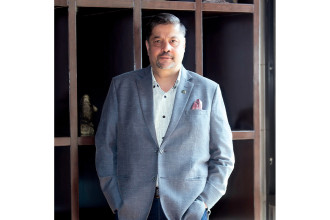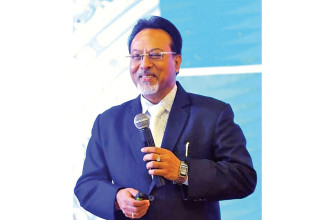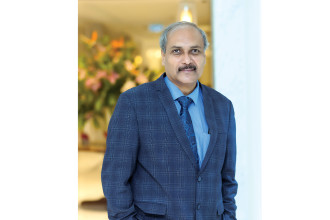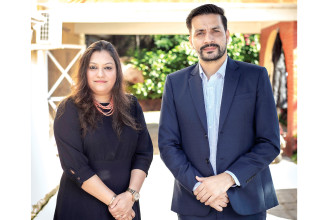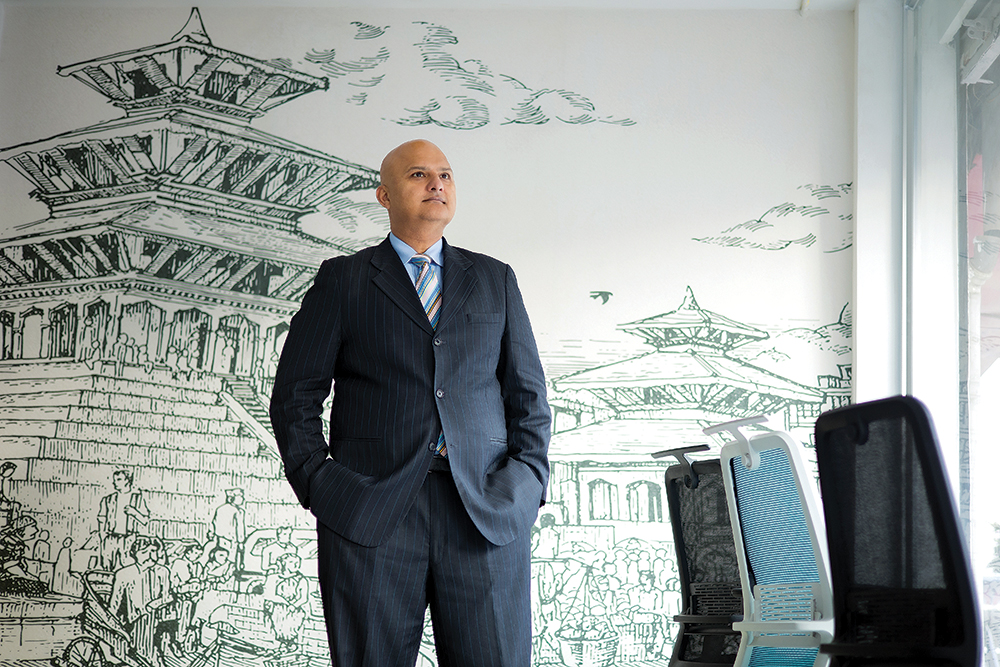
Kamlesh Malkani
Vice President, Asia Pacific – Channel Steelcase Inc
Since its establishment, Steelcase has been a global leader in office furniture, interior architecture and space solutions for offices, hospitals and classrooms. The furniture that is produced by the company is inspired by innovative research in workspace design. Steelcase leads the way in creating great experiences by offering a range of architecture, furniture and technology products and services designed to help people reach their full potential. In Nepal, the company has partnered with Fusion – Furniture Solutions to bring these world-class products to the Nepali market. Recently, Kamlesh Malkani, Vice President, Asia Pacific – Channel, Steelcase Inc, was in Kathmandu to take stock of the market. During his visit, Business 360 met with him to learn more about Steelcase and its plans for the market here. Malkani has over 25 years of comprehensive experience living and working in Asia, managing businesses with full operational profit and loss authority, directing regional business development, establishing independent dealer networks and organising early-stage start-ups. “I have different ideas in my mind through my experiences with different cultures which I think helps a lot because it is an amalgamation of various experiences,” he says, adding when he is faced with a lot of different creative questions in different geographies it allows him to use those experiences to assist him in his analysis of what he thinks the market needs. Based in Hong Kong, Malkani’s focus for Steelcase is the SAARC region apart from Asia Pacific. “My role is to expand our distribution and find new collaborative partnerships as we try to grow our geographical coverage in the Asia Pacific region,” he states. Excerpts of a conversation with Malkani:Could you tell us about Steelcase?
Steelcase is based out of Grand Rapids in Michigan, United States. The company started with innovation and till date it is renowned for its innovative products. Back in those days when Steelcase started, wastepaper baskets were made of wood and smoking was still common. There used to be a lot of fire incidents in offices as people would casually throw their cigarette butts in those bins without checking whether or not the cigarette had been put out. Thus, the first innovation that Steelcase came up was by creating a wastepaper basket made of metal. The company was born through innovation and we have continued to be innovative in how we solve problems for end users. You could say this was one of the reasons why I joined the company in 2014. I have been in this industry for a pretty long time and Steelcase at one point in my career was my strong competitor. I was impressed with the research that the company was undertaking and it is more extensive and intensive when compared to other organisations I have worked for. Steelcase was and still remains to be using the advantage of having the largest installation base of users globally to allow them to lead with insights. Moreover, the work ethic in the workplace is fantastic which I think is the most important aspect for any company. This was important pre-Covid and more so now in the post-Covid era.How has the office furniture market evolved over the years globally and for Steelcase in particular?
The office furniture market has gone through a lot of transformation over the years and even more now through the use of social media and the increase in knowledge within the industry. The use of specific furniture has become more prevalent. I think the reason why the industry has also grown is due to the shared knowledge where we have all collaborated with our ideas. At present, there is more professional research being conducted that continues to drive the learning with our industry partners whether it be architects or designers and project managers. They are all getting much more informed of what the market is seeking. That has been a very good aspect as it has driven us to be much more proactive in our growth, in our applications and designs and how we make our products. Steelcase has always been an office furniture manufacturer since it started. Over the last 15 years, the workplace has evolved tremendously and has been changing particularly with the drive of tech organisations. Tech organisations have been trying to braid the home workspace and office and a lot of spaces are becoming similar. We could take the chairs that we sit on for example and that was being driven before Covid and now too. The drive to create applications, scenarios and solutions that can address those in-between spaces is ongoing. At present, especially after the pandemic one of the solutions we are trying to figure out is how we can braid the physical and digital with products and overall in line with our DEI (diversity, equity and inclusion). DEI is a big part of our ethos. We want to make sure it is a big part of everything we do. We do things with that in our mind and we look at things through those lenses and also through ESG (environmental, social and corporate governance). That is another big drive we have. I am very happy to say that in the western part of the world it is being taken a lot more seriously. But having said that it is also being taken quite seriously now in emerging markets. For instance, in Hong Kong, the government has said that publicly listed companies on the Hong Kong Stock Exchange have to reflect the ESG standards and also promote them. So, I hope it now filters down to India and the entire SAARC region.How would you describe the market for Steelcase in the SAARC region and in Nepal particularly?
I would say the market in the SAARC region is exciting. It was since pre-Covid we started looking at how we could cover the SAARC region in a more meaningful way. We have had some amazing growth this fiscal year. Our fiscal year starts from March 1 till the end of February. The business revenue being generated out of the SAARC region in this fiscal will be a new high for us. We have been growing in double digits in the last few years. When it comes to Nepal, we see huge potential. We have had many dialogues and conversations with leading architects and designers and with end users in the last few days of my visit. I can assure you that I am confident going back with more commitment to the SAARC region. I do believe that in the next five years we will double our revenue in SAARC and that will include all the locations that we are present at within the region.How have you planned to further collaborate with Fusion, your partner in Nepal?
At Steelcase, we believe that our dealers are our partners. This basically means that if you are talking to any representative of Fusion then it is like talking to someone from the parent company. We are an extension here because we also hope our partners commit themselves to the same levels of compliance and codes that we ourselves adhere to. Whether it is about DEI or the operational part of how we do business, the ethical standards we follow, how we work with our colleagues, transparency and treating people with respect, we expect our partners to do the same. I know Fusion ticks a lot of those boxes for us. With Hitesh Golchha of Fusion, we are confident that his organisation will fulfil the expectations we have in the Nepali market.What do you think makes Steelcase products stand out in the market?
I would say you should choose Steelcase to experience the product and service. I could actually turn this question back on you and say why would you choose a Mercedes versus a Maruti Suzuki. Both cars are fantastic and both get you to your destination but it is that experience of going from point A to B which makes one brand better than the other. As you sit on a chair on a workday in the workplace, whether you are working from home or the office, you don’t realise you are sitting for eight to 10 hours on that chair. So that chair should support you whilst you are working. In fact, the desk should also support you whilst you are working At Steelcase, we have done a lot of research in ergonomics and the user behaviours in why our products have been designed the way they are. None of our products is just put in the market. All our products work for a purpose, for a reason. For instance, the chair you are currently sitting on is called the gesture chair. The idea behind the gesture chair was born because of technology. As smaller smart devices started being introduced in the market they were being used more in the workplaces and new postures were being created by the users. So, when new postures came, new supporting tools were required from the urbanomics point of view. Hence, the gesture chair was created after observing how different users were sitting in different postures and then creating a chair that was globally integrated. We make sure we design globally because our design concepts come from North America, India and Asia Pacific. We really have a lot of passion towards user-centric designs and that’s what makes us different from other companies. I don’t have the exact number but we spend hundreds of millions of dollars every single year on research and development. We also have a team called Workplace Future which is all about looking at trends and organisations and what the future looks like for them and then what we need to create out of our observation of how they are working. Hence, I can confidently say that when using a Steelcase product, you are actually experiencing something worthwhile.How does Steelcase perform on the sustainability quotient?
For example, there is the personality chair which was designed in Pune. When we look at that chair it is all about how much more can we domestically source. So, it is not only about getting materials from somewhere else and manufacturing our products in Pune. We look at how we can avail raw materials locally. When we do source materials locally then it saves on the freight energy that would have been required to bring them from far flung places, whether it is by rail or truck and then from Pune to Nepal. Steelcase has a big focus on being carbon neutral or carbon negative by 2030. These initiatives that we are taking have been set by ourselves. We want to be the leader not only in sales but in other aspects too. READ ALSO:- 'Our business in the entire Asian market has been immense and we are leaders in our segment'
- ‘If you look at the Doing Good Index there are four sets of indicators’
- ‘I was recently at a banking and finance conference in Kathmandu and it was an eye-opener for me’
- ‘We wanted to do something meaningful to raise the bar of sports in Nepal’
- ‘As long as Gulf governments subsidise their airlines, we can never talk of a level playing field’
Published Date: February 1, 2023, 12:00 am
Post Comment
E-Magazine
RELATED Face 2 Face


